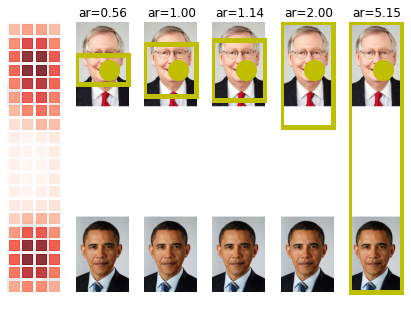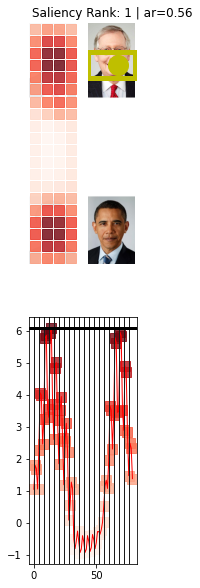Goal of the notebook
To walk the reader through the methodology used with regards to the 3 saliency cropping frameworks we have audited in our paper. We hope this will provide a clear insight into how we constructed a common ground for evaluating all these 3 frameworks.
In doing so, we also hope to educate the general audience on the fate of the infamous Obama-McConnell image (https://www.theguardian.com/technology/2020/sep/21/twitter-apologises-for-racist-image-cropping-algorithm) when passed through the Saliency cropping frameworks of Twitter, Google and Apple.
The constituent images produced here are stitched into a collage that forms the narrative sorrounding “Figure 1” in our paper.

1: Twitter’s Saliency Image Cropping (SIC) framework
The cell below is from the official Twitter github repo (https://github.com/twitter-research/image-crop-analysis)
import logging
import shlex
import subprocess
import sys
from collections import namedtuple
from pathlib import Path
import math
import seaborn as sns
import matplotlib.image as mpimg
import matplotlib.pyplot as plt
import numpy as np
from matplotlib.collections import PatchCollection
from matplotlib.patches import Rectangle
import pandas as pd
from tqdm.notebook import tqdm
logging.basicConfig(level=logging.ERROR)
######################################################
import platform
BIN_MAPS = {"Darwin": "mac", "Linux": "linux"}
HOME_DIR = Path("../").expanduser()
try:
import google.colab
! pip install --quiet pandas scikit-learn scikit-image statsmodels requests dash
! [[ -d image-crop-analysis ]] || git clone https://github.com/twitter-research/image-crop-analysis.git
HOME_DIR = Path("./image-crop-analysis").expanduser()
IN_COLAB = True
except:
IN_COLAB = False
sys.path.append(str(HOME_DIR / "src"))
bin_dir = HOME_DIR / Path("./bin")
bin_path = bin_dir / BIN_MAPS[platform.system()] / "candidate_crops"
model_path = bin_dir / "fastgaze.vxm"
data_dir = HOME_DIR / Path("./data/")
data_dir.exists()
True
Now, let us pass the image through the Twitter-SIC and see the results
##########################################################
from crop_api import ImageSaliencyModel, is_symmetric, parse_output, reservoir_sampling
import urllib.request
model = ImageSaliencyModel(crop_binary_path=bin_path, crop_model_path=model_path)
URL='https://pbs.twimg.com/media/EiT2SftUMAEjDRH?format=jpg&name=4096x4096'
img_path='obama_mitch.jpg'
urllib.request.urlretrieve(URL, img_path)# Retrieve and save
model.plot_img_crops(Path(img_path), topK=1,aspectRatios= None,add_saliency_line= False)
cmd = f"{str(bin_path)} {str(model_path)} '{Path(img_path).absolute()}' show_all_points"
output = subprocess.check_output(cmd, shell=True)
dict_output_img=parse_output(output)
dict_output_img['salient_point'],dict_output_img['crops']
# The crops are formatted as (x_top_left,y_top_left,width,height)
# Row order: aspectRatios = [0.56, 1.0, 1.14, 2.0, img_h / img_w]
plt.figure()
ax=model.plot_img_crops(Path(img_path), topK=1,aspectRatios= [0.56],add_saliency_line= True)
None 583 3000
[0.56] 583 3000
image-crop-analysis/src/crop_api.py:348: UserWarning: Tight layout not applied. tight_layout cannot make axes width small enough to accommodate all axes decorations
fig.tight_layout()

<Figure size 432x288 with 0 Axes>

2: Google’sCROP_HINTS API
Pass the image through the ‘Try it’ link in the documentation guide.
The output you will receive looks something like this:
dict_google={
"responses": [
{
"cropHintsAnnotation": {
"cropHints": [
{
"boundingPoly": {
"vertices": [
{
"y": 2400
},
{
"x": 579,
"y": 2400
},
{
"x": 579,
"y": 2725
},
{
"y": 2725
}
]
},
"confidence": 0.53422713,
"importanceFraction": 0.108567595
}
]
}
}
]
}
class DictX(dict):
def __getattr__(self, key):
try:
return self[key]
except KeyError as k:
raise AttributeError(k)
def __setattr__(self, key, value):
self[key] = value
def __delattr__(self, key):
try:
del self[key]
except KeyError as k:
raise AttributeError(k)
def __repr__(self):
return '<DictX ' + dict.__repr__(self) + '>'
hint={
"bounding_poly": {
"vertices": [
{"x": 0,
"y": 2400
},
{
"x": 579,
"y": 2400
},
{
"x": 579,
"y": 2725
},
{"x": 0,
"y": 2725
}
]
},
"confidence": 0.53422713,
"importance_fraction": 0.108567595
}
# hint=DictX(hint_google)
Extract the crop-hints results and visualize it:
from matplotlib.patches import Rectangle
verts=[[vertex['x'], vertex['y']] for vertex in hint['bounding_poly']['vertices']]
vert_mat=np.asarray(verts)
width_crop=np.max(np.abs(np.diff(vert_mat[:,0])))+1
height_crop=np.max(np.abs(np.diff(vert_mat[:,1])))+1
fig, ax = plt.subplots(figsize=(5,10))
x_image=mpimg.imread(img_path)
ax.imshow(x_image,aspect=1)
rect = Rectangle((vert_mat[0,0], vert_mat[0,1]), width_crop,height_crop,linewidth=5, edgecolor='yellow', facecolor='none')
ax.add_patch(rect)
plt.title(f'Google \n Confidence:{np.round(hint["confidence"],2)} | IF: {np.round(hint["importance_fraction"],2)}')
Text(0.5, 1.0, 'Google \n Confidence:0.53 | IF: 0.11')

3: Apple’s Attention-based saliency cropping (ABSC)
The idea here is to visualize the fate of the image if Twitter’s saliency estimation neural network was to be replaced by Apple’s. The cropping policy based on the max-salient points is held constant to perform an apples-to-apples comparison.
This requires Xcode 13.2.1 + Swift and the output 68 x 68 saliency grid output is saved here.
Now, in the code cell below, we inherit Twitter’s cropping-policy functions.
from PIL import Image
from collections import namedtuple
from matplotlib.patches import Rectangle
import logging
logging.basicConfig(level=logging.ERROR)
CropRectangle = namedtuple("CropRectangle", "left top width height")
def plot_crop_area(
img,
salient_x,
salient_y,
aspectRatio,
title_plt='default',
ax=None,
original_crop=None,
checkSymmetry=True,
):
if ax is None:
fig, ax = plt.subplots(1, 1,figsize=(5,10))
ax.imshow(img)
ax.plot([salient_x], [salient_y], "-yo", ms=20)
if (title_plt=='default'):
ax.set_title(f"ar={aspectRatio:.2f}")
else:
ax.set_title(f"{title_plt} ar={aspectRatio:.2f}")
ax.set_axis_off()
patches = []
if original_crop is not None:
x, y, w, h = original_crop
patches.append(
Rectangle((x, y), w, h, linewidth=5, edgecolor="r", facecolor="none")
)
ax.add_patch(patches[-1])
logging.info(f"ar={aspectRatio:.2f}: {((x, y, w, h))}")
# For non top crops show the overlap of crop regions
x, y, w, h = generate_crop(img, salient_x, salient_y, aspectRatio)
logging.info(f"Gen: {((x, y, w, h))}")
# print(x, y, w, h)
patches.append(
Rectangle((x, y), w, h, linewidth=5, edgecolor="y", facecolor="none")
)
ax.add_patch(patches[-1])
if checkSymmetry and is_symmetric(img):
x, y, w, h = generate_crop(img, img.shape[1], salient_y, aspectRatio)
logging.info(f"Gen: {((x, y, w, h))}")
# print(x, y, w, h)
patches.append(
Rectangle((x, y), w, h, linewidth=5, edgecolor="b", facecolor="none")
)
ax.add_patch(patches[-1])
return ax,(x, y), w, h
def generate_crop(img, x, y, targetRatio):
(
imageHeight,
imageWidth,
) = img.shape[:2]
imageRatio: float = (imageHeight) / imageWidth
if targetRatio < imageRatio:
# squeeze vertically
window = fit_window(y, np.round(targetRatio * imageWidth), imageHeight)
top = window[0]
height = max(window[1] - window[0], 1)
left = 0
width = imageWidth
else:
# squeeze horizontally
window = fit_window(x, np.round(imageHeight / targetRatio), imageWidth)
top = 0
height = imageHeight
left = window[0]
width = max(window[1] - window[0], 1)
rect = CropRectangle(left, top, width, height)
return rect
def fit_window(center: int, width: int, maxWidth: int):
if width > maxWidth:
raise RuntimeError("error: width cannot exceed maxWidth")
fr: int = center - width // 2
to: int = fr + width
if fr < 0:
# window too far left
fr = 0
to = width
elif to > maxWidth:
# window too far right
to = maxWidth
fr = to - width
return fr, to
def is_symmetric(
image: np.ndarray, threshold: float = 25.0, percentile: int = 95, size: int = 10
) -> bool:
if percentile > 100:
raise RuntimeError("error: percentile must be between 0 and 100")
return False
# downsample image to a very small size
mode = None
if image.shape[-1] == 4:
# Image is RGBA
mode = "RGBA"
imageResized = np.asarray(
Image.fromarray(image, mode=mode).resize((size, size), Image.ANTIALIAS)
).astype(int)
imageResizedFlipped = np.flip(imageResized, 1)
# calculate absolute differences between image and reflected image
diffs = np.abs(imageResized - imageResizedFlipped).ravel()
maxValue = diffs.max()
minValue = diffs.min()
# compute asymmetry score
score: float = np.percentile(diffs, percentile)
logging.info(f"score [{percentile}]: {score}")
score = score / (maxValue - minValue + 10.0) * 137.0
logging.info(f"score: {score}\tthreshold: {threshold}\t{maxValue}\t{minValue}")
return score < threshold
import cv2
url_csv='https://gist.githubusercontent.com/vinayprabhu/29da9a4a5a4d266149dd078d1817f542/raw/7e092af99e390d92b2d34000f440fd125af30d19/obama_mitch_apple.csv'
df_apple=pd.read_csv(url_csv,header=None)
print(df_apple)
sal_=df_apple.iloc[0,6]
list_sal=[float(s) for s in sal_[1:-1].split(',')]
mat_sal=np.array(list_sal).reshape(68,68)
heatmap_img=cv2.resize(mat_sal,(583,3000))
print('Max saliency point is:')
np.where(heatmap_img==heatmap_img.max())[1][0], np.where(heatmap_img==heatmap_img.max())[0][0]
0 ... 6
0 https://pbs.twimg.com/media/EiT2SftUMAEjDRH?fo... ... [0.051081724, 0.02944088, 0.025204398, 0.01637...
[1 rows x 7 columns]
Max saliency point is:
(304, 860)
plt.figure(figsize=(6,10))
plt.subplot(121)
url='https://i.ibb.co/1f1YsDT/obama-mitch-apple.png'
img_path='obama_mitch_apple.png'
urllib.request.urlretrieve(url, img_path)# Retrieve and save
plt.imshow(mpimg.imread('obama_mitch_apple.png'))
plt.title('Raw output \n from ABSC')
plt.subplot(122)
plt.imshow(heatmap_img)
plt.title('Upsampled 68x68 \n ABSC heatmap')
plt.tight_layout()
img=mpimg.imread('obama_mitch.jpg')
plot_crop_area(
img,
np.where(heatmap_img==heatmap_img.max())[1][0],
np.where(heatmap_img==heatmap_img.max())[0][0],
0.56,
'ABSC with \n Twitter\'s cropping \n :')
(<matplotlib.axes._subplots.AxesSubplot at 0x7f4108a80e90>,
(0, 697.0),
583,
326.0)

